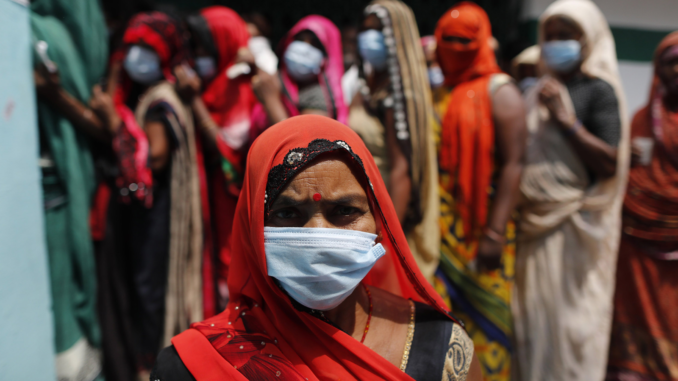
Aria Alva ’22
At the start of the pandemic, the Prime Minister of India, Narendra Modi issued a lockdown order demanding that all 1.3 billion citizens of India stay in their homes for three weeks. While this was an effective preventive measure for those who could afford to stay in their homes, many Indians suffering from poverty live in densely populated areas such as slums. These people are not able to socially distance themselves, cannot afford to work from home, and do not have access to proper sanitation. Shenaz Khatun, a mother who lives in one of these areas, told New York Times, “We dare not step out even to buy vegetables whose prices have skyrocketed. The future looks very dark. If Coronavirus does not kill us, hunger will.”
During 2020, the wealth gap in India increased dramatically as the billionaires of India continued to make money, while COVID forced around 75 million Indians into poverty. The lockdown caused significant damage to the lower and middle class. However, it effectively contained the virus and COVID cases began to slow near the end of September 2020. Many factors contributed to India’s initial success, as its median age is 28. Younger people have more robust immune systems and can often evade COVID. By the winter of 2020, the Bharatiya Janata Party announced that under Prime Minister Modi, the pandemic in India was defeated.
Per contra, the BJP was mistaken. By the end of March 2021, the second wave of COVID skyrocketed case numbers which averaged more than 350,000 new diagnoses per day. In an article for PennToday Harsha Thirumurthy, an associate professor of medical ethics and health policy at Perelman School of Medicine, says this “has been quite a perplexing issue for many folks who have been studying the pandemic.” Thirumurth states that this spike in cases is most likely a result of the following factors.
While India’s first lockdown was very successful, the BJP’s attitude of completely relaxing the lockdowns and lack of focus on possible preventive measures for the future left the country vulnerable to COVID. Mass gatherings were allowed for festivals such as Kumbh Mela, a Hindu celebration of washing away past sins, and invited the virus’s spread. As these gatherings were allowed, a message was sent to the citizens of India that practicing social distancing was no longer necessary. In addition to these festivals, rallies for the 2021 election occurred between March 27th and April 29th. Prime Minister Modi may have claimed to be the perpetrator of India’s original success, but he also contributed to its downfall. The Prime Minister not only held many of these political rallies for the election, but encouraged mass participation. The second possible reason for India’s spike in cases is the new B.1617 variant of COVID-19. This variant of the virus is easily more transmissible and many Indians with antibodies are being reinfected.
In order to suppress this new variant, the BJP needs to sacrifice its political agenda to enforce social distancing and mask requirements. According to Thirumruthy, the second initiative that needs to be taken is to “greatly accelerate pace of vaccinations in India. As of now, we’ve seen something like 3% of the Indian population being fully vaccinated.” Nonetheless, India is one of the largest producers and exporters of COVID vaccines. India is not the only country experiencing a new variant of COVID. A second wave is also occurring in South America in places such as Uruguay and Brazil. India’s current crisis is a reminder against complacency, as the appearance of new variants and the second wave of COVID is possible not only in the United States but worldwide.